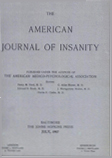INSULIN SHOCK TREATMENT OF SCHIZOPHRENIA
Abstract
The method used and general observations made during insulin shock treatment of schizophrenia are discussed.
From November, 1936, to March, 1939, 76 cases of schizophrenia were treated; 56 of them finished the complete course of therapy, the remaining 20 are either still taking the treatment or the treatment was interrupted for various reasons.
A higher percentage of patients in China compared with those in western countries proved to be unfit for insulin shock treatment. Observations point more to climatic than to racial differences.
From this study, the prospect for remission appears to be dependent on the duration of the disease, the type and course of schizophrenia as well as the form of the onset, cases with an acute onset showing more inclination for remission than those with a gradually progressive course.
The duration of the treatment until remission is not dependent on the duration of the disease.
Remissions in certain cases with protracted treatment or late remissions after shock therapy cannot be positively considered as the result of the shock therapy.
The shock dose shows lower average values in cases with shorter duration of the disease than in chronic cases. The dose required for a shock usually decreases during the course of treatment.
In one particular case, the shock dose fluctuated in accordance with the mental condition of the patient.
Relapses occurred in 5 of the 20 cases with full remission after the shock therapy.
I wish to express my thanks to Drs. John C. Tseng and Richard Wang for their valuable assistance.
Access content
To read the fulltext, please use one of the options below to sign in or purchase access.- Personal login
- Institutional Login
- Sign in via OpenAthens
- Register for access
-
Please login/register if you wish to pair your device and check access availability.
Not a subscriber?
PsychiatryOnline subscription options offer access to the DSM-5 library, books, journals, CME, and patient resources. This all-in-one virtual library provides psychiatrists and mental health professionals with key resources for diagnosis, treatment, research, and professional development.
Need more help? PsychiatryOnline Customer Service may be reached by emailing [email protected] or by calling 800-368-5777 (in the U.S.) or 703-907-7322 (outside the U.S.).



